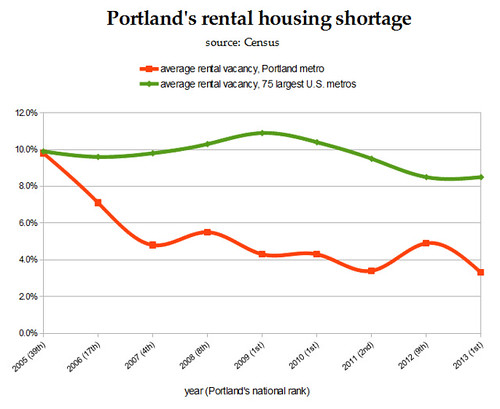I’m happy to introduce the Real Estate Beat, a new editorial focus that will be covered by BikePortland News Editor Michael Andersen. With his past experience as publisher of Portland Afoot Michael is the perfect person to cover this for us. He’ll help you understand why real estate development and housing issues have major implications for people who lead a low-car lifestyle. — Jonathan
—
For decades, Portlanders have been looking for bike-friendly, transit-accessible, walkable real estate to live, shop or work in.
Now, low-car real estate has finally come looking for us.
The evidence is all around. This year and next, dozens of new apartment buildings are rising in the central city without any on-site auto parking spaces, including the 118-unit Emery nearing completion in the South Waterfront and the 81-unit 37th Street Apartments on SE Division Street. These buildings are going up for a reason: Portland is fun, attractive and (compared to most of the United States) prosperous, all of which makes people want to move here, which has led to a deep and chronic shortage of rental housing.
By this spring, our rental vacancy rate was tied for the country’s lowest:
Housing shortages are hard to solve because housing takes up space, and space in a vibrant central city is expensive. But housing that doesn’t require on-site parking is far more space-efficient. In a way you can measure in dollars and cents — about $20,000 for every on-site auto parking space that a building doesn’t have to provide — low-car life is helping solve Portland’s housing problem.
Change is afoot in the world of commercial real estate, too. Portland’s booming set of talent-driven tech and marketing startups have become important tenants of local office buildings, and they’re looking for real estate that best fits happy, healthy workers who like to bike, walk, run or skate to work. Hard-nosed retail analysts are looking at the value per square foot of storefronts with good bike access and concluding that bikes can bring more customers to a store without increasing congestion or making the neighborhood less pleasant. The commercial real estate market is responding by embracing outdoor bike parking and making indoor parking and showers standard at the region’s best office buildings.
Bikes aren’t the only mode that matters here — they’re just one essential component of the world’s growing enthusiasm for urban life. Walk Score, the Seattle-based web startup that has worked itself into the heart of the U.S. real estate industry, just added Bike Score to its Walk Score and Transit Score ratings as a way to evaluate the attractiveness of a given address. Nelson/Nygaard, one of the country’s leading transit consulting firms, has begun consulting with private developers who want to understand low-parking housing projects. The City of Portland is aiming to quadruple the residential population of downtown over the next 20 years.
And all this change matters — because the most important thing behind most people’s choice of how to get from A to B isn’t politics, money or weather. It’s the location of Point A and the location of Point B.
Or, as someone else once put it: Location, location, location.
Portlanders’ location preferences are changing, and the city and country are noticing. This is the history we’ll be writing together with Real Estate Beat.
Some subjects you’ll see us cover here:
- the latest local apartment permits with low auto-parking ratios
- major new commercial buildings on bike and transit corridors
- amenities and prices at local bike-oriented apartments and condos
- ways low-car development does (and doesn’t) keep central-city housing affordable
- creative cohabitation strategies for Portlanders making the most of our existing stock of bikeable housing
- the surprising link between food cart pods and downtown office space
- in-depth interviews with the city’s smartest real estate professionals
Welcome to a story that is, in every sense, developing. If you know a real estate story that needs telling, get in touch.



